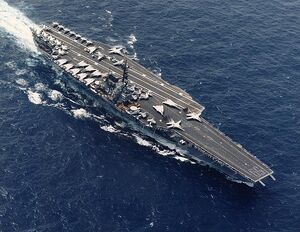 USS Forrestal (CVA-63) in 1993. | |
| Class overview | |
|---|---|
| Name: | Forrestal-class aircraft carrier |
| Builders: | New York City Navy Yard Newport News Shipbuilding |
| Operators: | United States Navy |
| Preceded by: | United States class aircraft carrier |
| Succeeded by: | Kitty Hawk class aircraft carrier |
| In commission: | 1 October 1955 – 30 September 2009 |
| Completed: | 4 |
| Laid up: | 4 |
| General characteristics | |
| Displacement: | 60,000 tons standard 75,000 tons full load 90,000 tons max load |
| Length: | 1,084 ft (330 m) overall 990 ft (300 m) waterline |
| Beam: | 129 ft 4 in (39.42 m) waterline |
| Draft: | 35 ft 9 in (10.90 m) |
| Propulsion: | Steam turbines, 280,000 shp |
| Speed: | 34 knots (63 km/h) |
| Complement: | 4,378 |
| Armament: | Original armament: 8 × 5 in/54 caliber Mark 42 guns Refit armament: 3 × 8 cell NATO Sea Sparrow Mark 29 missile launcher launchers 3 × 20 mm Phalanx CIWS Mark 15 guns |
| Aircraft carried: | Up to 90 |
| Aviation facilities: | 330 × 77 m flight deck |
The Forrestal-class aircraft carriers were four heavy aircraft carriers designed and built for the United States Navy in the 1950s. It was the second class of so-called supercarriers, combining high tonnage, deck-edge elevators and an angled deck. The first ship was commissioned in 1955, the last decommissioned in 2009.
Design
The Forrestal class was the second completed class of "supercarriers" of the Navy, so called because of their then-extraordinarily high tonnage (75,000 tons, 25% larger than the post-World War II-era Midway class aircraft carriers but smaller than the Soviet Union's Project 1143.7 Ulyanovsk), full integration of the angled deck (Forrestal and Saratoga were laid down as axial deck carriers and converted to angled deck ships while under construction; Ranger and Independence were laid down as angled deck ships and had various minor improvements compared to the first two), a very large island and most importantly their extremely strong air wing (80–100 jet aircraft, compared to 65–75 for the Midway class and fewer than 50 for the Essex class aircraft carrier). Compared to the Midway class, the Forrestals were 100 feet (30 m) longer and nearly 20 feet (6 m) wider abeam, resulting in a far more stable and comfortable aircraft platform even in very rough weather. When commissioned, the Forrestal class ships had the roomiest hangar decks and largest flight decks of any carrier ever built. Because of their immense size they were built to a new, deep-hulled design that incorporated the armored flight deck into the hull (previous American design practice was to design the flight deck as superstructure). This was a very similar structural design as used on British Illustrious class aircraft carrier, and grew out of the requirement for such a very large carrier, because carrying the strength deck at the flight deck level produced a stronger and lighter hull. The Midway class ships sat very low in the water and were poor sea boats through their long careers; they were very wet forward and their aviation characteristics were poor. The deeper Forrestal hull allowed the ships more freeboard and better seakeeping. The Forrestal-class carriers, like the Midway class that preceded it, were designed with armored flight decks.
Forrestal-class ships were the first examples of supercarriers and thus not quite a perfected design; their elevators in particular were poorly arranged for aircraft handling. The portside elevator, a relic of the original axial-deck design, was almost completely useless, as it was located at the fore end of the angled deck, in the landing path as well as the launch path of aircraft from the #3 and #4 catapults. The subsequent Kitty Hawk class aircraft carrier moved the portside elevator to the aft end of the angle and reversed the position of the island and the second starboard elevator, vastly improving aircraft handling. The sponson-mounted guns suffered from poor range and complicated firing arcs, and were located in very wet and thus nearly useless positions in the bow and stern; they were removed after only a few years and replaced by missiles and close-in weapon systems (CIWS). In Forrestal, the aft guns lasted until the fire in 1967, then were removed and eventually replaced by missiles in the mid-70s.
The original design of the Forrestal class ships would have had a very small, retractable island; this design had numerous problems (the mechanism to raise and lower the island was never perfected before the angled deck was added to the design) and smoke fouling of the deck was expected to be a severe problem due to lack of adequate venting. The redesign to an angled deck allowed a very large island, much larger than on previous carriers, giving unprecedented flexibility and control in air operations.
Ships in class
| Builder | Ordered | Keel laid | Launched | Commissioned | Decommissioned | Status | |
|---|---|---|---|---|---|---|---|
| Forrestal | Newport News Shipbuilding and Drydock Co., Newport News | 12 July 1951 | 14 July 1952 | 11 December 1954 | 1 October 1955 | 11 September 2009 | In reserve |
| Saratoga | New York City Navy Yard, New York City | 23 July 1952 | 16 December 1952 | 8 October 1955 | 14 April 1956 | 20 August 2009 | In reserve |
| Ranger | Newport News Shipbuilding and Drydock Co., Newport News | 1 February 1954 | 2 August 1954 | 29 September 1956 | 10 August 1957 | 10 July 2008 | In reserve |
| Independence | New York City Navy Yard, New York City | 2 July 1954 | 1 July 1955 | 6 June 1958 | 10 January 1959 | 30 September 2009 | In reserve |